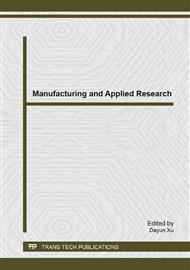[1]
H.B. Huntington, in: Diffusion in solids, edited by A.S. Nowick and J.J. Burton, Academic Press Inc., New York (1975), p.303.
Google Scholar
[2]
I.A. Blech and H. Sello, in: Physics of failure in electronics, edited by T.S. Shilliday and J. Vaccaro, Rome Air Development Center, Rome (1966), p.496.
Google Scholar
[3]
C.M. Tan and A. Roy: Mater. Sci. Eng., R Vol. 58 (2007), p.1.
Google Scholar
[4]
H. Ceric and S. Selberherr: Mater. Sci. Eng., R Vol. 71 (2011), p.53.
Google Scholar
[5]
M. Saka and R. Nakanishi: Mater. Lett. Vol. 60 (2006), p.2129.
Google Scholar
[6]
H. Park, A.K.L. Lim, J. Park , A.P. Alivisatos and P.L. McEuen: Appl. Phys. Lett. Vol. 75 (1999), p.301.
Google Scholar
[7]
D.E. Johnston, D.R. Strachan and A.T.C. Johnson: Nano Lett. Vol. 7 (2007), p.2774.
Google Scholar
[8]
G.E. Begtrup, W. Gannett, T.D. Yuzvinsky, V.H. Crespi and A. Zettl: Nano Lett. Vol. 9 (2009), p.1835.
DOI: 10.1021/nl803800c
Google Scholar
[9]
J. Sarkar, G.G. Khan and A. Basumallick: Bull. Mater. Sci. Vol. 30 (2007), p.271.
Google Scholar
[10]
R. Dou and B. Derby: Scr. Mater. Vol. 59 (2008), p.151.
Google Scholar
[11]
M. Saka, F. Yamaya and H. Tohmyoh: Scr. Mater. Vol. 56 (2007), p.1031.
Google Scholar
[12]
G. Cao and D. Liu: Adv. Colloid Interface Sci. Vol. 136 (2008), p.45.
Google Scholar
[13]
A. del Campo and E. Arzt: Chem. Rev. Vol. 108 (2008), p.911.
Google Scholar
[14]
I.R. Musin and M.A. Filler: Nano Lett. Vol. 12 (2012), p.3363.
Google Scholar
[15]
I.A. Blech, P.M. Petroff, K.L. Tai and V. Kumar: J. Cryst. Growth Vol. 32 (1975), p.161.
Google Scholar
[16]
Y.J. Chen, J.H. Hsu and H.N. Lin: Nanotechnology Vol. 16 (2005), p.1112.
Google Scholar
[17]
J.J. Wang, F. Liu, X. Deng, X. Liu, L. Chen, P. Sciortino and R. Varghese: J. Vac. Sci. Technol. B Vol. 23 (2005), p.3164.
Google Scholar
[18]
C. Li, W. Ji, J. Chen and Z. Tao: Chem. Mater. Vol. 19 (2007) p.5812.
Google Scholar
[19]
Y. Lu, H. Tohmyoh and M. Saka: J. Phys. D: Appl. Phys. Vol. 44 (2011), p.045501.
Google Scholar
[20]
Y. Kimura and M. Saka: Mater. Lett. Vol. 116 (2014) p.278.
Google Scholar
[21]
R. Zanma and M. Saka: Int. J. Mater. Struct. Integrity (2013), accepted.
Google Scholar
[22]
H.B. Huntington and A.R. Grone: J. Phys. Chem. Solids Vol. 20 (1961), p.76.
Google Scholar


